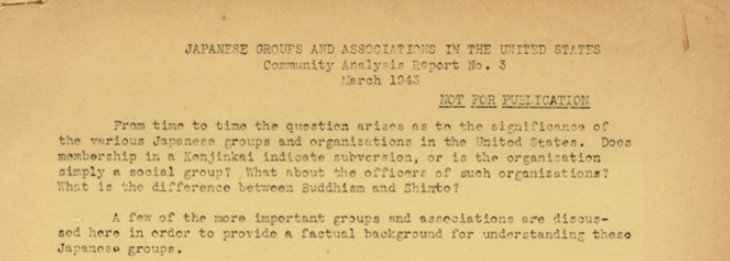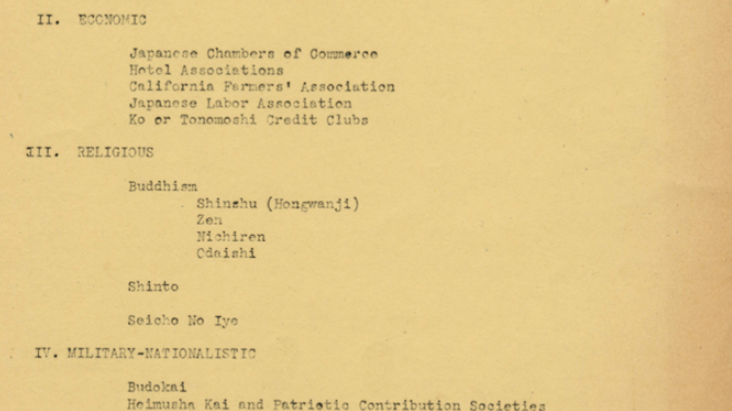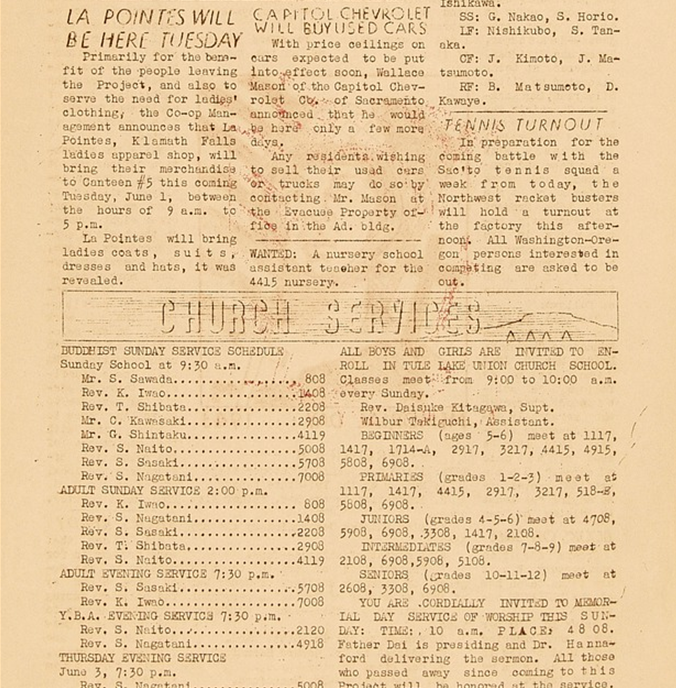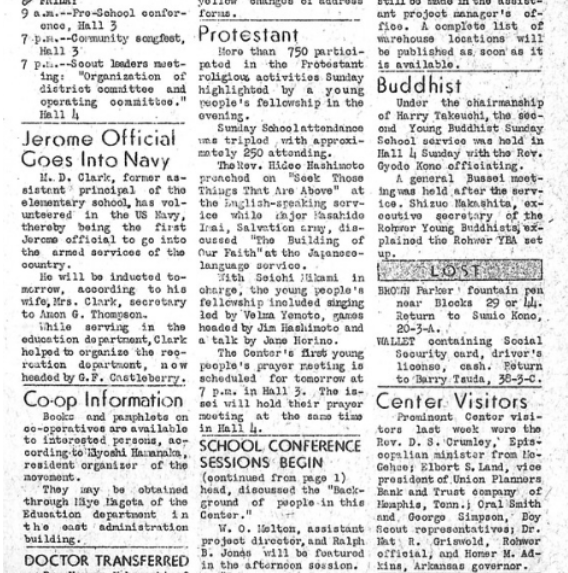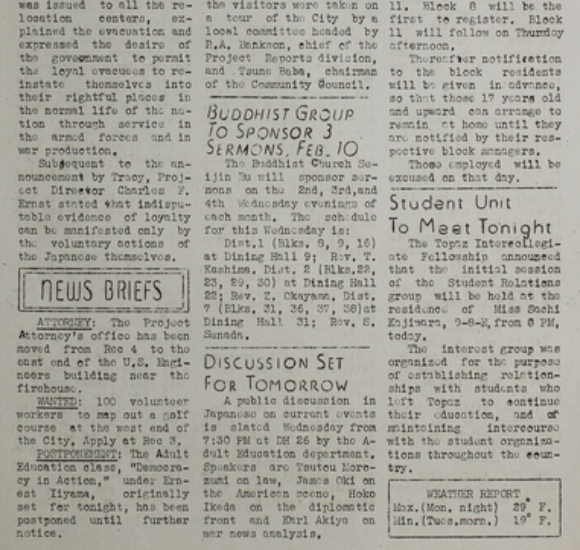Last updated: September 1, 2022
Article
(H)our History: Buddhism in WWII Incarceration Camps
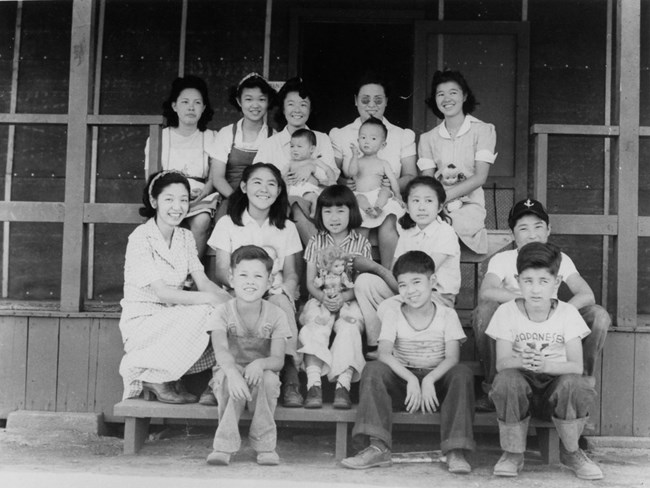
NPS Photo, Manzanar National Historic Site
This lesson was adapted from the article Buddhism Under Japanese Incarceration During WWII. It can be taught as part of a unit on Japanese Incarceration and World War II or when teaching World Religions.
Grade level adapted for:
This lesson is intended for middle school learners but can easily be adapted for use by learners of all ages.
Learning Objectives
Students will be able to…
-
Identify the role Buddhism played in the lives of Japanese Americans during and after incarceration in World War II
-
Explore the ways that religion, like other aspects of culture, shows continuity and change in communities under pressure
Inquiry Question:
“Japanese Groups and Associations in the United States
“Community Analysis Report No.3
“March 1943 Not for Publication
“From time to time the question arises as to the significance of the various Japanese groups and organizations int he United States. Does membership in a Kenjinkai indicate subversion, or is the organization simply a social group? What about the officers of such organizations? What is the difference between Buddhism and Shinto?
“A few of the more important groups and associations are discussed here in order to provide a factual background for understanding these Japanese groups...”
II. Economics
Japanese Chambers of Commerce
Hotel Associations
California Farmers’ Association
Japanese Labor Association
Ko or Tonomoshi Credit Clubs
III. Religious
Buddhism
Shinshu (Hongwanji)
Zen
Nichiren
Odaishi
Shinto
Seicho No Lye
IV Military-Nationalistic
Budokai
Heimusha Kai and Patriotic Contribution Society
-
What is the purpose of this list?
-
Why might U.S. officials put different Buddhist groups and religious denominations on this list? Think about context, what you know is happening at the time.
Background Reading:
In 1942, President Franklin Delano Roosevelt signed Executive Order 9066, which forcibly relocated approximately 122,000 Americans of Japanese descent to incarceration camps, over 70,000 of whom were American citizens. Although Roosevelt only specified “any and all persons” from areas of the country deemed “vulnerable to attack or sabotage,” the military applied the order to Japanese Americans without levying individual or specific charges.1 People were forced to leave their homes and were settled in ten camps in seven states. Previously classified documents reveal that a large part of the reasoning for targeting Japanese Americans was not just their race, but their religion.2
A majority of Japanese Americans in incarceration camps were Buddhist. Buddhism is one of the major world religions, with over 480 million adherents in 2020, primarily in southern and eastern Asia. Buddhism was founded by Siddhartha Gautama, often known as the Buddha, more than 2,500 years ago. There is no single supreme deity. Instead, the focus is on achieving enlightenment, a state of inner peace, by understanding the four Noble Truths: the truth of suffering, the causes of suffering, the end of suffering, and the path that frees everyone from suffering. For some Japanese Americans, Buddhism offered a framework for understanding and enduring incarceration because of the emphasis on self-reflection.
Time in the incarceration camp had different effects on Buddhism in the Japanese American community. For some, it strengthened their faith and renewed attention to Buddhist rituals and practices. For others, incarceration and the war generally provoked further efforts to assimilate. Some Japanese Americans converted to Christianity, while Buddhist groups also changed the language around rituals and practices using terms like “Buddhist Church” and “Sunday School” to conform to American religious norms.
While in the incarceration camps, many Japanese Americans kept traditions like the Bon Odori festival alive. Camp administrators could not regulate these festivals, and clergy held regular services. Buddhist leaders also helped organize civic projects and offered emotional support to people while incarcerated. When Japanese Americans were released from the camp, some people were able to retrieve possessions stored in Buddhist temples. The United States government did not formally apologize or pay reparations to Americans interned until the 1980s, but Japanese Americans worked to rebuild after the war, often with Buddhist temples at the center of their communities.
Questions for students:
1. What was Executive Order 9066? Why did it impact Americans of Japanese descent?
2. Why is it important to think about the role of Buddhism in the lives of Japanese Americans, both during and after incarceration?
Activity: The Fabric of the Community
As Japanese Americans sought stability and some feeling of normality, they established schools, stores and community centers. In most camps, people created local newspapers, both to provide information and entertainment. These newspapers provide valuable insights into daily life in the incarceration camps and the resilience of the Japanese American community.
Ask students to go to the following links from the Tulean Dispatch at the Tule Lake Segregation Center in California, the Denson Communique at the Jerome Camp in Arizona and the Topaz Times in Topaz Relocation Center, Utah. All three papers were written and published by people incarcerated in the camps. They should look for mentions of Buddhism- How Buddhism is mentioned, where it fits into the other items on the page and any inferences about what this means for the place of Buddhism in people’s lives. Some parts of the article are transcribed below but teachers may want to send students to the Densho Repository to see the whole context.
"Church Services”
"Church Services"
Left side of image:
Buddhist Sunday Service Schedule
Sunday School at 9:30 a.m.
Mr. S. Sawada...808
Rev. K. Iwo........1408
Rev. T. Shibata...2208
Mr. C. Kawasaki.,..2908
Mr. G. Shintaku...4119
Rev. S. Naito....508
Rev. S. Sasaki...5708
Rev. S. Nagatani...7008
Adult Sunday Service 2:00 pm
Rev K. Iwo...808
Rev. S Nagatani...1408
Rev. S. Sasaki...2209
Rev. T. Shibata...2908
Rev. S. Naito...4119
Adult Evening Service 7:30 p.m.
...
Right side of image:
All boys and girls are invited to enroll in the lake union Church School. Classes meet from 9:00 to 10:00 a.m. every Sunday
Rev. Daisuke Kitagawa, Supt.
Wilber Takiguchi, Assistant
Beginners (ages 5-6)
...
You are Cordially Invited to Memorial Day Service of Worship this Sunday: Time: 10 a.m. Place: 4808.
Father Dei is presiding and Dr. Hannaford delivering the sermon. All those who passed away since coming to this Project will be honored at the service. ...
"Buddhist”
“Buddhist”
“Under the chairmanship of Harry Kaeuchi, the second Young Buddhist Sunday School service was held in Hall 4 Sunday with the Rev. Gyodo Kono officiating. A general Bussei meeting was held after the service. Shizuo Nakashita, executive secretary of the Rohwer Young Buddhists explained the Rohwer YBA set up.”
"Buddhist Group to Sponsor 3 Sermons”
“Buddhist Group to Sponsor 2 Sermons, Feb 10.
“The Buddhist Church Seijin Bu will sponsor sermons on the 2nd, 3rd, and 4th Wednesday Evenings of each month. The schedule for this Wednesday is...”
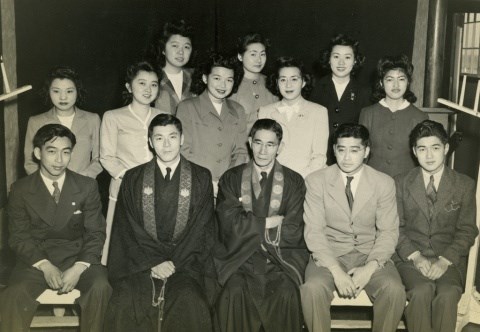
George Ochikubo Collection, available for educational, non-commercial projects
Students will answer the following questions based on their observations.
-
What does the placement and the language around Buddhism in these newspapers tell us about the role of Buddhism in people’s lives in the incarceration camps?
-
What are the similarities and differences between the presentation of Buddhism and Protestantism in the newspaper? How might that support or refute some historians’ arguments that Buddhist leaders worked to make the religion more “American” by adopting language from Christianity?
-
How does the role of Buddhism in the incarceration camps and for Japanese Americans compare to your experiences with different faiths in your community? Does anything surprise you about these primary sources?
Activity: Buddhism after the War
Listen to Ryo Imamura’s interview about Buddhism and the Japanese American community. Imamura was born in the Gila River incarceration camp and his father was Rev. Kanmo Imamura, who was a Bishop in Hawaii and former leader in the Buddhist Churches of America. Imamura is a professor of Psychology and an ordained Buddhist minister, focusing his research and teaching on East-West Psychology and Buddhist thought. Students can discuss the questions when they are finished.
Interview with Ryo Imamura, Segment 10, August 3, 1999. Densho Digital Repository. https://ddr.densho.org/interviews/ddr-densho-1000-27-10/
Ryo Imamura (RI): I think in community activities, just generally speaking, Buddhist Nikkei tend to be, not less active, less in the leadership positions than say Christian Nikkei. A lot has to do with the gospel in a way of Christians are encouraged to go out and serve the community and organize and be very visible in that way. So they form a lot of these charities and various service groups and so on. So right away you say well, this Christian church, whether it's Japanese or not, has all these programs in the community. You look at the Buddhist temple and you don't see this organization. And you don't see people talking about their service to the community 'cause there's nothing in Buddhism of earning points, or wanting to -- there being a difference of going up or down or anything like that. It's all done out of gratitude. And when you do things out of gratitude, it's very understated. It's almost hazukashii, and, a little embarrassment of having received so much one didn't deserve, so, "Hey, if I could just anonymously send some money out, or help out, then this is much, much better." So, I think Buddhists do donate a lot. They do a lot of public service and all that, but they don't tie it to say a Buddhist cause or organize in that way. …
[Interviewer]: So typically if you compared maybe say a Japanese American Methodist church versus a Buddhist temple, the Buddhist temple would have very few kind of organized groups that are supposed to... the refugee committee or the Habitat for Humanity group, or, you know all of that. In a lot of JA Protestant churches they seem to have that kind of mechanism, I guess you want to call it. But in Buddhist temples you wouldn't have it, but the same thing would be accomplished typically?
RI: I think on an individual basis a lot is happening. But I think, say if you're a Japanese Christian church you belong to a national organization of, well mostly Caucasian churches. But, they have programs and they send you their literature, and maybe give you training, and there's kind of a model for doing those things. So it's not like you're creating something new, but rather you're keeping up with the other churches. In the Buddhist case there is no model like that. We're poor. We came out of camps, as kind of a new generation. I think it's changing that way. But the leaders in all these causes have traditionally been the clergy. And as long as we still rely upon clergy from Japan, where they don't even know about racism there, or they claim not to, right -- and, or being a minority, or understanding. Certainly people from Japan who come here don't identify with people of color here as being a distinct underprivileged minority. In fact over there the ones who come here often -- the privileged, educated class. And so when that consciousness isn't there, and the ministers, especially those that come from Japan, you don't get that kind of encouragement or leadership. Often the messages that come from headquarters saying, "Okay there's a social welfare fund," or, "Let's discuss the issue about abortion or something," it means nothing to the minister from Japan. So that literature gets filed away and never disseminated to the members…
-
How does Ryo Imamura describe the difference between community practices in Buddhism and Judeo-Christian?
-
What is the relationship between Japanese Americans and Japan through Buddhism, even after World War II? How does that impact their activism in the US Community?
-
What does Ryo Imamura describe as ways Buddhism in the Japanese American community has changed or not changed after World War II and incarceration?
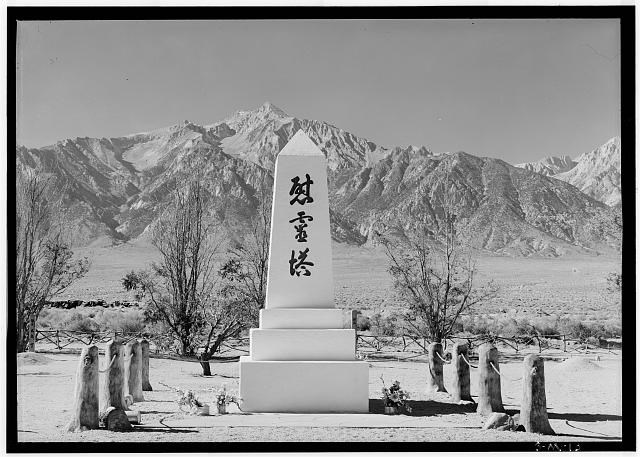
Retrieved from The Library of Congress
Activity: Interfaith Monument
Students will examine the Manzanar Cemetery Monument and read a little about it, then discuss the following questions.
The Manzanar Cemetery Monument was built to honor the dead at Manzanar War Relocation Center, which interned more than 10,000 Japanese Americans. Matsunosuke Murakami, age 62, was the first of the 150 Americans of Japanese ancestry to die at Manzanar on May 16, 1942. Ryozo Kado, a Catholic stonemason, and Shinjo Nagatomi, a Buddhist minister, designed the monument cooperatively. Every family in the camp donated 15 cents to fund construction and the labor was done by residents and a young Buddhist group. The Japanese kanji characters on the monument read “I REI TO'' or “Soul Consoling Tower.” Rev. Nagatomi also chiseled “Erected by the Manzanar Japanese, August 1943” on the opposite side.
Though many families reburied their dead or took cremated remains home after 1945, the monument remains an important site for remembering the war. Buddhist minister Sentoku Mayeda and Christian minister Shoichi Wakahiro made the first pilgrimage back to the monument on Memorial Day in 1946. They continued to make this pilgrimage for thirty years to honor those that died at Manzanar. During the Civil Rights movement, young Japanese Americans spoke out and organized, inspired by African American leaders. In raising awareness of the injustice of the incarceration camps, 150 people traveled to the monument in December 1969. The Manzanar Pilgrimage has become an annual event, with hundreds of people from diverse backgrounds gathering on the last Saturday in April for a day of remembrance. There are speeches, a memorial service, and a traditional ondo dance. People also travel year-round on personal pilgrimages to reflect, remember, worship, or protest, many leaving small objects as offerings. This monument, built by Japanese Americans of Buddhist and Christian faiths, remains a site of reflection on the lives of Japanese Americans and the injustices of incarceration.
-
What do you notice when you look at the monument? What does it make you think of? Why do you think the memorial was designed this way?
-
How does the monument represent culture and religion? How does it have a wider significance than just to Buddhists?
-
When people make pilgrimages to the monument, they often leave items as offerings. Sometimes those objects are religious, other times they are personal. What can objects say about the beliefs and experiences of a community? How can they help pass on memory? What would you leave if you took the pilgrimage to Manzanar?
Wrap Up
-
How did Buddhism shape Japanese American experiences in World War II?
-
How does Buddhism, and other religious and cultural practices, connect people to their past, particularly traumatic events like Japanese incarceration?
Additional Resources:
This exhibit at the Japanese American National Museum, “Sutra and Bible: Faith and the Japanese American Incarceration” explores Japanese American religion and culture during World War II. This includes a video early in the exhibit. The exhibit is co-curated by Rev. Dr. Duncan Ryuken Williams, the director of the University of Southern California’s Shinso Ito Center for Japanese Religions and Cultures and author of the book American Sutra, about Buddhism in incarceration camps.
The Harvard Pluralism Project has an article on the Incarceration Crisis and Buddhism as part of their larger exploration of American Buddhism. The Harvard divinity school also has a case study on the subject.
For oral history interviews and other primary sources, the Densho Digital Repository has an extensive collection on Japanese American incarceration, with many that touch on internees’ Buddhist faith.
This page of Bill Manbo’s photographs from his time incarcerated at Heart Mountain Relocation Center give a powerful glimpse into life in the camps, including the preservation of Buddhist traditions like the Bon Odori festival in 1944.
This lesson was researched and written by Alison Russell a NCPE intern with the Cultural Resources Office of Interpretation and Education.
Tags
- wwii
- wwii home front
- japanese american
- asian american
- aapi
- aapi history
- aapi heritage
- religion
- religion and wwii
- hour history lessons
- buddhism
- japanese american incarceration
- japanese american history
- asian american and pacific islander heritage
- asian american and pacific islander history
- world war ii home front
- manzanar national historic site
- california

